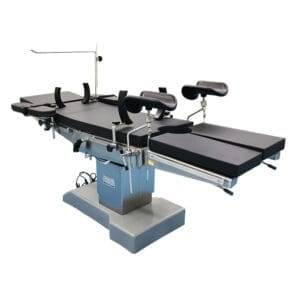Address
304 North Cardinal St.
Dorchester Center, MA 02124
Work Hours
Monday to Friday: 7AM - 7PM
Weekend: 10AM - 5PM
Address
304 North Cardinal St.
Dorchester Center, MA 02124
Work Hours
Monday to Friday: 7AM - 7PM
Weekend: 10AM - 5PM
The operating room, a sanctuary of healing and precision, demands meticulous attention to infection control. Amid the complex web of strategies and equipment designed to prevent infections, operating tables emerge as a cornerstone. Beyond their role as platforms for surgery, operating tables play a vital role in infection prevention and control. This article explores the intricate ways in which operating tables contribute to infection control in operating rooms, shaping patient safety, surgical outcomes, and the broader landscape of healthcare.
 A Silent Threat
A Silent ThreatSurgical site infections (SSIs) pose a significant threat to patient safety and well-being. These infections can lead to extended hospital stays, increased healthcare costs, and even mortality. Preventing SSIs requires a multi-faceted approach, and operating tables are a critical component of this defense.
Operating tables create a platform for aseptic techniques, essential to minimizing the risk of SSIs. The table’s design, material, and compatibility with infection control protocols collectively contribute to maintaining a sterile environment.
Operating tables crafted from non-porous, easy-to-clean materials are pivotal in infection control. Non-porous surfaces minimize the accumulation of microorganisms and make thorough cleaning and disinfection feasible.
Stainless steel, renowned for its durability and corrosion resistance, is a common choice for operating table surfaces. Its non-porous nature and resistance to chemical agents make it an ally in the fight against microbial colonization.
Advancements in material science have led to the development of surfaces with inherent antimicrobial properties. These materials actively inhibit the growth of pathogens, enhancing infection control efforts.
Operating tables must seamlessly integrate with sterilization protocols to ensure a sterile surgical field. Their design should allow for easy disassembly and reassembly, facilitating thorough sterilization between procedures.
Operating tables compatible with autoclaves and various disinfection methods provide flexibility in infection control. Proper sterilization of table components minimizes the risk of residual contamination.
Fluid management is a critical aspect of infection control. Operating tables equipped with effective drainage systems prevent the pooling of fluids that can serve as breeding grounds for pathogens.
In procedures involving irrigation and aspiration, the risk of aerosolization of contaminated fluids is present. Operating tables with efficient fluid containment mechanisms mitigate the spread of aerosolized pathogens.
Ergonomically designed operating tables facilitate proper positioning of patients, minimizing the need for frequent adjustments during surgery. This promotes adherence to aseptic techniques, reducing the risk of contamination.
Operating tables that allow for optimal patient positioning also limit the movement of surgical personnel around the sterile field. Reduced movement minimizes the introduction of contaminants and enhances infection control.
-300x300.jpg) Real-Time Visualization
Real-Time VisualizationOperating tables that integrate with imaging technologies enhance infection control by minimizing the need for repositioning during procedures. Real-time visualization allows surgeons to assess the surgical field without disturbing the sterile environment.
The integration of imaging systems reduces the need for personnel to enter the sterile field to view X-rays or imaging screens. This limits the potential for contaminants to breach the aseptic barrier.
Ongoing research explores the potential of advanced surface coatings that actively repel pathogens. These coatings could provide an additional layer of defense against microbial colonization.
The integration of UV-C disinfection systems within operating tables is a concept on the horizon. UV-C light can effectively kill pathogens on surfaces, bolstering infection control efforts.
Q1: How do operating tables contribute to infection prevention?
A1: Operating tables contribute to infection prevention through their design, material selection, compatibility with sterilization, and integration with fluid management systems.
Q2: What materials are commonly used for infection control on operating tables?
A2: Stainless steel, known for its durability and non-porous nature, is a common choice for operating table surfaces. Advanced materials with antimicrobial properties are also emerging.
Q3: How do operating tables minimize aerosolization of fluids?
A3: Operating tables with efficient fluid containment mechanisms minimize the risk of aerosolization during procedures involving irrigation and aspiration.
Q4: How can operating tables reduce the need for repositioning during surgery?
A4: Operating tables that integrate with imaging technologies allow real-time visualization, reducing the need for repositioning and limiting contamination risks.
Q5: What are some future innovations in infection control with operating tables?
A5: Advances in surface coatings and the integration of UV-C disinfection systems within operating tables are potential innovations to enhance infection control.
Operating tables are silent guardians of sterility in the operating room. Their contribution to infection control extends beyond their role as platforms; they are key players in the defense against surgical site infections. Through material selection, compatibility with sterilization, ergonomic design, and integration with imaging technologies, operating tables actively shape the aseptic environment that is essential for successful surgeries. As healthcare continues to evolve, the focus on infection control remains steadfast, with operating tables at the forefront of this relentless pursuit of patient safety and well-being.